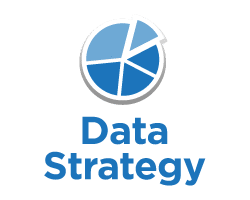Data Strategy
In the long run questions like “what is the need for a data strategy? and what kind of problems will it solve?” will pop up. However, to answer these questions, you have to fully understand the data strategy framework, examples, analytics, and enterprise data strategy. Well, we’ll discuss all this and more in this article.
It’s also important to consider and compare how data was created and used in the past to how it is being created and used today.
Businesses operate very differently in our world today the value of data has been accepted. Compared to the past when data was perceived as a byproduct of business activity or process. As a result, many new business initiatives have made data the secret of reporting and analytics. It’s now common for application data to be shared with as many as 10 other systems.
What is Data Strategy?
A data strategy refers to an orderly strategy for organizing, governing, analyzing, and deploying an organization’s information assets that can apply through industries and levels of data maturity. It’s also the vision for how a company will collect, store, manage, share and use data. Hence, Data Strategy requires an understanding that data needs are basic in the Business Strategy.
Moreover, the idea behind developing a data strategy is to make sure all data resources are positioned in such a way that they can be used, shared, and moved easily and efficiently. Data is no longer a byproduct of business processing. it’s a critical asset that enables processing and decision making. A data strategy helps by ensuring that data is managed and used as an asset. It provides a common set of goals and objectives across projects to ensure data is used both effectively and efficiently. A data strategy establishes common methods, practices, and processes to manage, manipulate and share data across the enterprise in a repeatable manner.
It’s the opportunity to take your existing product line and market it better, develop it better, use it to improve customer service, or get an accurate degree of understanding of your customer. Data Strategy is driven by your organization’s overall Business Strategy and business model.
Read Also: The Bad Side Of PayPal You Probably Are Oblivious To
Why do Businesses Develop a Data Strategy:
#1. To think of the future trends and how to best manage them.
#2. Support the re-imaging of decision-making in an organization at all levels.
#3. To manage streams of data that are critical to a company’s success.
#4. To drive change and establish a data culture.
#5. To develop a sustainable competitive advantage given the volume, depth, and accessibility of digital data.
Data Strategy Example
Let’s consider the data strategy example of a consulting team helping a large company to develop a data strategy. The project manager found it hard to get his superior to understand the need for and importance of a data strategy from the start. Why? The company was already successful. Its revenue and costs were well-managed, and the individual business units and technology groups were good at delivering against their commitments. To the company’s credit, it wasn’t self-satisfying. However, the management was always looking for ways to increase staff members’ productivity and reduce ongoing costs. Whereby, all kinds of metrics and key performance indicators (KPIs) were made to measure IT performance, business benefits, and total cost of ownership. The idea of building yet another road map to address a problem that wasn’t well-understood met with pushback.
With the company doing so many things right, the MD needed to understand why and how a data strategy would make a difference.
What the MD didn’t know. The results of reporting and analytics have made data the secret sauce of many new business initiatives. Hence, it’s easy to share application data with as many as 10 other systems. Meanwhile, sharing and accessing application data is one of the challenges his employee are facing.
However, organizations need to create data strategies that match today’s realities to improve work efficiency. To build such a comprehensive data strategy, they need to account for current business and technology commitments. While also addressing new goals and objectives.
Read Also: FAIR VALUE ACCOUNTING: Definition & Benefits of Fair Value Accounting
Data Strategy Framework
Let’s look at the REI data strategy framework: how they could reduce time to insights with collaboration and improve their retail experience.
REI, America’s largest consumer co-op and specialty outdoor retailer, has a brick-and-mortar and digital presence with 150 stores in 36 states and 16 million members. With growth and popularity, REI has quickly accumulated an abundance of customer data. Moreover, with this data in hand from transactions online and in-store, operations information, and buyer demographics. One primary objective for the REI data strategy framework is providing a more personalized customer experience.
However, with the data strategy framework adoption across the organization, supported by a collaborative relationship between business units and IT. REI has streamlined data analysis efforts. As a result, teams are more effective at gathering and assessing key customer insights to elevate REI’s impact in the marketplace. Hence, driving a better customer experience and influencing business strategy. Historically, REI analysts spent 80 percent of their time and effort performing data preparation tasks and the rest of their time was spent finding the right way to convey information to stakeholders. However, their decision to implement a data strategy framework and plan out a more collaborative relationship between business and IT teams was one of their best decisions.
Looking to the future, REI uses analytics to set strategic essentials and uncover opportunities that will create the greatest impact on customers.
Analytics Data Strategy
Analytics data strategies are changing the way enterprises do business. However, organizations that know how to tap into information and use it effectively have a competitive advantage over those that don’t. Meanwhile, let’s discuss some of the analytics data strategies:
#1. Analytics Data Strategy Platform
An Analytics Platform is a complete and unified solution for managing data and generating business analytics, using traditional and advanced methods, to however empower decision-makers to do their jobs. It also allows analyzing relevant data from any source, in any format, and from any location with speed, security, and scale. So It gives the business the flexibility to leverage cloud or on-premises deployments to meet dynamic business requirements.
#2. Analytic Discovery
Analytic Discovery encompasses the ability to swallow all available data into an analytic platform. Where current methods, technologies, and processes leverage to support quick discovery beyond the traditional reporting and devise analytics processes that are common today. However, the objective is to enable rapid data exploration, modeling, sharing, and learning in a supporting discovery environment. While also focusing on developing plans to operationalize discoveries into business systems, applications, and business processes to drive desired outcomes.
Read Also: What is a Reverse Auction: A Comprehensive Guide for Complete Mastery
#3. Analytics Data Strategy Workflow
Analytic Workflow is an arranged and repeatable pattern of business activity enabled by the systematic organization of resources and technologies into business processes and workflows. Hence, as business processes mature, these workflows become codified. Sorted (automated) workflows ensure repeatability and quality control, particularly for situations with a high volume of transactions or data-intensive business processes such as demand-driven sales and operations planning.
#4. Information Delivery
Information Delivery is the ability to deliver apt and prompt analytics at the right time and in the right format to drive business decisions. It also takes many forms in delivering information to the business including reports, dashboards, scorecards, visualization, spatial and geographic display through self-service, scheduled, mobile, and desktop access. As you focus on operationalizing analytics into widespread business applications and processes, plan to deliver to your key stakeholders when, where, and how they need it.
#5. Hybrid Data Management Strategy
A Hybrid Data Management strategy is critical for efficiency and flexibility, ideally analyzing all business-relevant data, drawing insights from that data, and putting those insights into action. Furthermore, this process area deals with managing and provisioning all data via a modern analytic platform that optimizes existing business intelligence (BI) technologies and integrates advanced analytics into business processes – spanning all types of data sources including structured/unstructured, machine/human-generated, and streaming/batched.
#6. Information Governance
Information Governance (IG) focus is on maintaining the quality of the information vital to the organization. A set of structures, policies, procedures, processes, and controls to manage information and data in order to support regulatory, legal, risk, environmental, and operational requirements. Effective IG implies strategic data and information assets are managed like all other strategic assets.
Read Also: BUSINESS PORTFOLIO ANALYSIS: Overview, Templates & How to Make One
Enterprise Data Strategy
An enterprise data strategy is a complete vision and plan for an organization’s future to tackle data-dependent capabilities. It stands as the cover for all domain-specific strategies, such as master data management, business intelligence, big data e.t.c.
Reasons Why Organizations need an Enterprise Data Strategy
#1. Avoids the burden of unnecessary data. Working through an enterprise data strategy should make your enterprise more aware of the total amount of data collected and stored. Furthermore, part of this awareness will come from documenting key data life cycles. Like understanding how much data carry on in different applications and determining how long the data is considered workable.
#2. Establishes decision-making authority for data governance and data management. A thorough analysis of your existing data universe should include an assessment of accountability and ownership for each data source and application. This is also a critical part of an enterprise data strategy. However, by establishing this mechanism for accountability through your data stewardship and data governance activities, and also shoring up areas that need improvement. Then consider the stewardship demands of big data.
#3. Helps set priorities with the existing data sources.
The first step in designing an enterprise data strategy is to collect an inventory of all data sources, applications, and data owners. This step illustrates the range and twists of your data totality and provides the basis for decision-making. It also demonstrates – to executives and those responsible for managing the data life cycle – where the gaps and competing priorities for resources exist.
Read Also: Enterprise Risk Management: Overview, Framework, Competencies
#4. Requires you to rethink the data you collect, the value, and the risks. Data introduces both value and risk to every organization. There are legal discovery issues to be aware of, and sharing, reporting, storing, or archiving data. Moreover, this may introduce exposure to regulatory initiatives. Hence, use this info to assess the risk your data exposes you to before you start to advance for new big data sources.
#5. Improves the effectiveness of data quality processes. A sturdy enterprise data strategy will display the data touch points for data quality monitoring and correction processes. This may also include data integration points and areas for active data stewardship intervention. Hence, you can apply this info to reduce inconsistencies, redundancies, or gaps in data quality activities.
In Conclusion
Finally, placing together an enterprise data strategy should be a fundamental responsibility of any organization that’s serious about using data to provide insights and direction effectively.
FAQs
Who is a data strategist?
Data strategists are in charge of the entire sourcing process for alternative datasets, and they frequently collaborate with quants, data scientists, and portfolio managers. They assist in the screening of datasets in order to choose those that are likely to show promise and meet the business’s needs.
Why is a data strategy important?
A data strategy aids in the management and use of data as an asset. It establishes a consistent set of goals and objectives for all projects, ensuring that data is utilized effectively and efficiently.
What is a data analytics strategy?
An analytics strategy should evaluate an organization’s specific business difficulties, match those challenges to appropriate data and resources. Build mechanisms to grow capabilities and institutionalize analytics so that key decision-makers have access to actionable outcomes.
How do you create a data strategy?
- The first step in developing a data strategy is to write a proposal and use it to gain buy-in from all levels of your company.
- Assign Data Governance Roles and Form a Data Management Team
- Set goals for data collection and distribution by identifying the types of data you want to collect and where it will come from.
- Establish a Data Strategy Data Storage and Organization Roadmap Plan
- Obtain approval and begin putting your data strategy into action.
- HR ANALYTICS: Importance, Examples, Courses, Jobs
- Customer relationship: Everything you need to know (+ free strategy plan)
- DECISION-MAKING STYLES: Understanding the 4 Decision Making Styles for Leaders
- BUSINESS INTELLIGENCE (BI): Definition, Importance, Tools & Benefits
- 7 business growth hacks for 2021 [with guide]
- Psychographic Segmentation: Advantages, tools (+ practical examples)
- Naming Photography Business: Best Complete 2022 Guide & Creative Ideas






